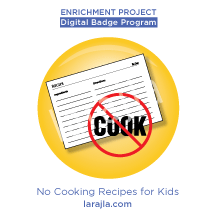 Make sure you try any recipes you will be introducing to kids before doing so. Make any adjustments you feel need to be made so the recipe acceptable to your kids. This includes removing / replacing ingredients that might cause allergic reactions.
Make sure you try any recipes you will be introducing to kids before doing so. Make any adjustments you feel need to be made so the recipe acceptable to your kids. This includes removing / replacing ingredients that might cause allergic reactions.
Steps
1. No experience.
Lacking the experience to help kids who might not have cooked before? If so, check out the Enrichment Project badge program “Cooking Basics.”
2. Recipe cards.
When you’re ready to use cards, hand the card out to the kids to review together. Review what is on the card and make sure they understand what everything means, including abbreviations. Discuss what might happen if directions weren’t followed.
NOTE: Blank recipe cards are also included in case you want to use your own recipes.
3. Allergies.
Before you work on “no cook recipes”, discuss allergies with your kids. Make sure they understand that they cannot mix ingredients in case someone is allergic to it. If any of your kids have food allergies, ask them to discuss what they are allergic to, what they do to avoid it and what happens when they are exposed.
4. Clean-up.
Prepare a kaper chart so everyone knows what part of the clean-up they are responsible for doing. Discuss the proper way to clean to make sure everything is sterilized. Make sure all leftovers are properly stored. Provide all cleaning materials and / or storage items necessary.
No cooking required
5. Snack mixes.
Provide various dried items for the kids to create a snack mix or trail mix. Provide a blank recipe card for them to create their own recipe as they add items to their mix.
- Cereal
- Dried fruit
- Nuts (only if there is no one with allergies)
- Dried fruit
- Candy
Two recipe cards are in our sample file for variations on snack / trail mixes.
Take a small walk so they can eat while they move. As you hike, ask the kids what else they might include in their mix. Ask the kids to adjust their recipe cards when you are done.
6. Flavorings.
Prepare popcorn ahead of time. Have a variety of items to add to the popcorn so the kids can see how adding different “flavors” affects the popcorn. Start with plain popcorn and have them rate it. Then add items like powdered butter or cheese, caramel, etc. Again, have blank recipe cards for them to track their favorite toppings.
7. Ice cream in a can.
You can do this with cans, zip-top bags or even commercially available tools. Have the kids do all the measuring and shaking (or kicking). You can also provide ice cream toppings for additional flavor choices.
8. Fruit and vegetable dips.
Fruit dips can be used with a variety of fruit. Discuss the various fruits and vegetables available at different times of the year and why. Supervise kids with any sharp items if they are old enough to handle a knife. Cut the fruit and vegetables after the dips are made.
9. Dessert in a bag.
Mixing items in a zip-top bag minimizes mess. Try one or more recipes in a bag.
10. Exploring more.
Look through the recipe cards or find a recipe that doesn’t fit the above categories and try it with the kids.
11. Encourage kids to continue cooking.
Look for ways for kids to continue cooking. A cooking party featuring two or three recipes is a good rainy day activity. Starting a cooking club allows the kids a way to explore seasonal foods. Even cooking at home will allow them to continue improving their skills. What other ways can you encourage kids to cook?
Supplements
Sites to Explore
- kidshealth.org/kid/recipes
- busycooks.about.com/od/summerrecipesandmenus/a/nocookdesserts.htm
- www.realsimple.com/food-recipes/recipe-collections-favorites/quick-easy/no-cook-recipes-00100000085378/#1
- main.kitchendaily.com/no-cook-recipes/kid-friendly
- allrecipes.co.uk/recipes/tag-5515/kids-no-cook-recipes.aspx
- www.kidactivities.net/category/snacks-no-bake-recipes.aspx
- www.momswhothink.com/kids-recipe/kids-recipes-a-to-z.html
Leave a Reply